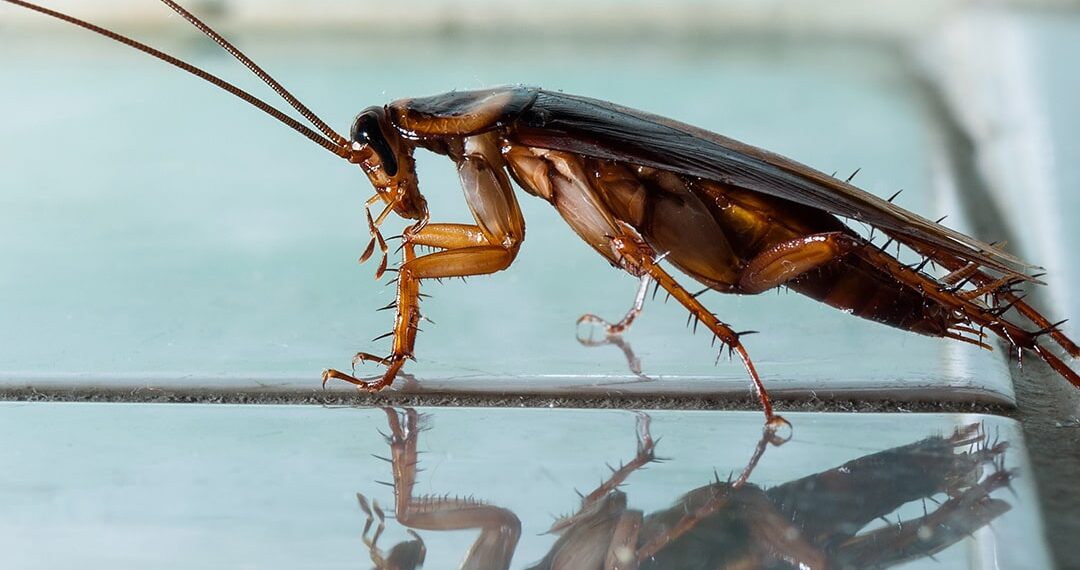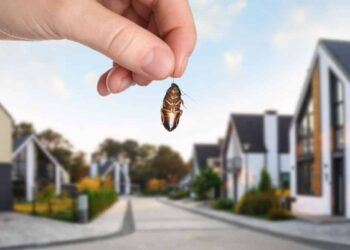Cockroaches reproduce rapidly and can go unnoticed, resembling adult cockroaches even as larvae near nests. While some stay outdoors, others enter homes. Despite differences, all cockroaches share a common life cycle. This discussion explores the concept and deeps inside of the cockroach life cycle, examines the appearance of cockroach larvae, and provides methods to eliminate and prevent their growth indoors.
Cockroaches Developmental Process
Cockroach eggs, incubated for 3 to 80 days, eventually hatch into miniature versions of adult cockroaches, lacking larvae. Unlike some insects, cockroach nymphs, not larvae, progress through growth stages, shedding skin as they mature.
The nymphs, often pale white but varying in markings, lack wings until their final developmental stage. Notably, nymphs of different species, like the Cuban cockroach, may display distinct colours, deviating from the typical pale appearance
Can Cockroach Larvae Be Mistaken for the Larvae of Other Insects?
When considering- cockroach larvae, one might imagine pests spread over spoiled food, yet cockroach nymphs differ significantly. Unlike legless caterpillars relying on food liquefaction, cockroach larvae climb on their legs, chewing on various substances.
As these larvae transition to pupae, undergoing moulting once or twice, they transform into insectivores with a distinct appearance. Meanwhile, cockroach nymphs grow, shedding their exoskeletons, akin to skin removal, and each moult results in increased size and hardness.
Adult cockroaches, having ceased moulting, can quickly occupy spaces and reproduce prolifically. Spotting one cockroach suggests the potential presence of many more, though not all cockroaches dwell indoors, as most prefer outdoor habitats.
Regardless of size or habitat, all cockroaches share a common life cycle.
Know How to Say Goodbye to House Bugs: A Step-by-Step Guide to Identification, Prevention, and Control
How Many Cockroaches Typically Emerge From One Egg Carton
Cockroaches undergo hatching from eggs, usually enclosed in egg cases carried by the mother or placed in a secure location for incubation. Some species, like the Australian rhinoceros cockroach, show ovoviviparity, where eggs hatch internally, and live young are born.
An egg carton usually holds 10-60 eggs, with the majority containing 14-30. Upon hatching, nymphs are prepared to mature, representing the predominant life stage as not all cockroaches reach adulthood.
Life Cycle of a Cockroach

The life of a cockroaches consists of three phases:
Stage 1- The Eggs (Ootheca)
The ootheca, or eggshell covering, is found in the female cockroaches’ abdomen. An ootheca sack contains about 50 eggs that are produced by the fertilised female cockroach. In order to safeguard the eggs until they reach the nymph stage, the cockroaches transport them in the ootheca.
The amount of eggs an ootheca can carry varies from one species to the other. Depending on the environment they reside in, these eggs may hatch into nymphs.
Stage 2- The Nymph
The cockroach enters the second stage as a tiny nymph. The nymph cockroach undergoes several stages of moulting and shedding of skin. It transforms into a white-coloured body with each moulting. Gradually the nymph becomes larger in size and its exoskeleton becomes more rigid and darker in colour.
The time period for the nymph stage varies from one species to another. It also depends on environmental factors and the presence of predators. The nymph stage lasts for a span of 11 to 14 months. Once the nymph finishes multiple stages of moulting and develops parts like wings, it enters the adult stage.
Stage 3 – The Adult
The nymph cockroach’s two wings are one way to differentiate it from an adult cockroach. Different cockroach species have different life spans. While some species only survive for two months, others can thrive for nearly two years.
Cockroaches are omnivorous by nature and will eat everything, including leftover meals from the previous night and even thin strips of paper. A mature female cockroach can give birth to 300 to 400 young ones during her lifespan.
Certain species spend the majority of their lives as nymphs, transforming into adults after only a few months. In contrast, some species have remarkably long-lived adults that can survive up to ten years. Despite these variations, most cockroach species have a lifespan of less than two years, during which they can generate numerous cockroach larvae.
Identifying Eggs

The appearance of the eggs and the place of hatching indicate which species are in the housing. Egg cases, also known as otheca, resemble small round beans with distinct edges on the sides. The usual colour is dark brown, but it can vary according to the type of chip. For example, the otheca of the German cockroach can be pale and yellow. Size also varies, with American and Oriental rook eggs being distinctly longer.
Where Do Cockroaches Usually Lay Their Eggs?
- The main force that attracts pests is food, and it’s no different for cockroaches. They prefer moist environments and need to be close to a food source to feed themselves and future cockroaches.
- The kitchen and the bathroom are two risky places where cockroaches nest. See the list below for more detailed sections and other attractive house zones.
- Surfaces
- Cabinets
- Appliances behind and under
- Under sink
- Drainage
- Pedestals
- Bathroom cabinets
- Laundry
How to Get Rid of Cockroach Eggs
These insects can be very annoying. Once your home is infested, getting rid of cockroaches and their nests can be very difficult. Anything that can kill an adult roach may not kill the eggs. And, of course, killing the adults does not remove the latents already hidden in the thief.
Also read- Strange Tiny Red Bugs In Your Window Everything To Know!
What Can You Do?
Well, you divide and conquer. If the infection persists, treating the eggs is a good starting point. Here’s how to take care of cockroach eggs:
Find the Eggs
First you have to find their hiding places. Since we have already mentioned some of the more common places, you can start exploring them. Remember that eggs are well hidden, often in hard-to-reach places.
Remove the Cockroach
- If you find a cockroach egg, remove it with gloves or a paper towel.
- Then squeeze the waiting bag and discard it in a plastic bag.
- Do not throw the plastic bag in the local waste bin.
- Throw it as far away from your home as possible.
DIY- Removal of Cockroach Eggs
Buttermilk
Buttermilk is an excellent choice for killing cockroach eggs. Try this method if you are sure that your house is already infested.
- It is made from marine phytoplankton, which is toxic to cockroaches and can dry out the skin.
- Be sure to buy the food grade version.
- Then sprinkle the powder in places where cockroaches are often seen.
Baking Soda and Sugar

- You must completely rid your home of pests after eggs and adults. You can try this method to get rid of egg producers.
- Prepare a mixture of equal parts baking soda and sugar in a small container.
- Spray it on the places where you saw cockroaches. This is one of the easiest cockroach killers.
Eliminating Cockroaches at Indoors
- Regularly inspect for cockroach presence, focusing on cleanliness, eliminating food sources, and sealing entry points.
- Utilize roach traps, vacuuming, essential oil sprays and minimal risk pesticides for effective home cockroach control.
- Deploy boric acid, diatomaceous earth, and silica air gel in strategic areas like attics and wall space and corners.
- Use gel baits and bait stations for larger roaches.
- Promptly wash dishes, clean spills, eliminate standing water sources, and manage pet bowls.
- Thoroughly clean and store vulnerable items like vegetable matter and cardboard.
- Dispose of trash daily, especially before bedtime, and maintain regular floor sweeping.
- Avoid prolonged exposure of pet food outside and store dry ingredients in sealed containers.
- Keep perishables refrigerated and maintain cleanliness in cooking equipment, including special areas.
- Wipe down surfaces nightly with lemon oil-infused water to deter cockroach return.
- Promptly recycle or dispose of newspapers and cardboard.
- Address fountain issues promptly and fix leaks while regularly checking appliances for excess moisture.
Conclusion
Cockroaches pose a significant home pest challenge, rapidly multiplying and penetrating interiors through concealed entry points. Their nature and resilience make eradication difficult. Apart from being carriers of diseases, they also contaminate food and surfaces.
In contrast to their role in nature, where they consume decomposing matter, in homes, they are persistent problems. Identifying their distinct appearances is crucial for effective pest control and preventing their growth.
FAQ
What is a Cockroach Larva?
Cockroaches do not have a larval or pupal stage. They emerge from their hatched eggs as nymphs, tiny versions of adults, and then grow into adults without dramatic changes.
What Attracts Cockroaches?
They are particularly attracted to crumbs, spills and food scraps, especially starchy and sugary products. Wet environments like leaky pipes and standing water also attract cockroaches. Cluttered and dark spaces provide shelter, and a warm environment creates ideal conditions for their activity.
What Pest Control is Used for Cockroaches?
The most common materials and methods used by exterminators to kill cockroaches are gel bait insecticides, fumigation, boric acid, Hydramethylnon and fipronil.
How Do You Get Rid of Cockroach Larvae?
To successfully get rid of the eggs, you need to get them as far away from your property as you can. Try to carefully collect them. Once you have gathered them all, take the eggs outside and throws them.
What Kills Roach Eggs?
You can buy what are called desiccant dusts like diatomaceous earth, a non-toxic substance you can dehydrate the eggs, thereby killing them.









